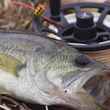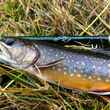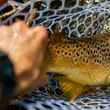These days, it’s easy to become overwhelmed by the huge selection of equipment on the market and the nuanced worlds of the two-handed fly fisher and streamer angler are no exception. Here we'll place polyleaders and sink-tips under the microscope to help you better understand the choices available and the right time to use each.
What is a Polyleader?
A polyleader (also called a versileader by some companies) serves two primary purposes for spey casting. First, it helps anchor your line to the water when performing a spey cast. All that means is they grip the water better than a traditional nylon leader, which helps you load the rod more efficiently. Second, because polyleaders have more mass than a traditional leader, they help turn flies over, especially in windy conditions — which can also be a benefit for anglers fishing big, tough-to-turn-over flies on single-hand rods. Outside of these primary purposes, a sinking polyleader can also be used instead of a sink-tip in certain fishing situations — more on that in a minute.
Like a traditional leader, a polyleader has a taper. However, they have a mono core (nylon) and a polyurethane coating. At the business end of the leader (the fly end) you will find an 8” section of the mono core exposed. Most anglers tie a perfection loop into this butt section, which allows them to create a loop-to-loop connection with their 3’ to 5’ section of tippet.
Polyleader Sizes
Polyeaders are available in a wide range of both length and breaking strength. In general, the 10’ leaders with a 24 lb core strength are the most popular for both steelhead and trout fishing. Leaders with a 40 lb core are useful when casting #8, #9 and #10 weight Spey rods or when using them in conjunction with skagit style lines ranging from #5 weight or heavier.
Polyleader Sink Rate (Density)
Polyeaders are available in a variety of densities ranging from "floating" to "extra super fast sink." Floating and intermediate densities are useful when fishing on or near the surface. As a side note, I personally use the intermediate when skating dry flies for steelhead or when fishing mouse patterns for trout with skagit heads like the Airflo Rage Compact. When it’s time to go subsurface, I break out the sinking densities.
Sink Tips
Sink tips carry along all the benefits of a polyleader, with the added benefit of a level or flat construction. This means that, unlike polyleaders, sink tips have no taper and are the same diameter at the business end (the fly end) as they are in the back end. The result is considerably more mass. As a result, sink tips will get down in the water column much faster than a polyleader coated with material with the same sink rate. Along these same lines, other mass-related benefits — anchoring your line, loading your rod, turning over flies — are also more pronounced with sink tips.
When To Use a Sinking Polyleader vs. a Sink-Tip
Although polyleaders come in sinking densities, as noted they don’t have as much mass as a level “T” sink-tip (for example: T-10). Consequently, they work great for small to medium size flies that are un-weighted or lightly weighted. That being said, their taper allows them to land on the water with more stealth than a heavy sink-tip making them perfect for tough fishing situations. In the end, you’ll want to rely on sink-tips like T-7, T-10 and T-14 for dredging large, heavy flies and reserve your polyleaders for those times when the fish are shallow and spooky.
Summary
As an streamer fisherman or spey angler for both steelhead or trout, polyleaders should be in your arsenal of tools and you should take care to note that they are offer great benefits even when casting lighter flies. If you need to go subsurface, sinking polyleaders are great for stealth but you'll want to utilize your sink-tips when fishing larger, heavier flies in deeper water.































Comments